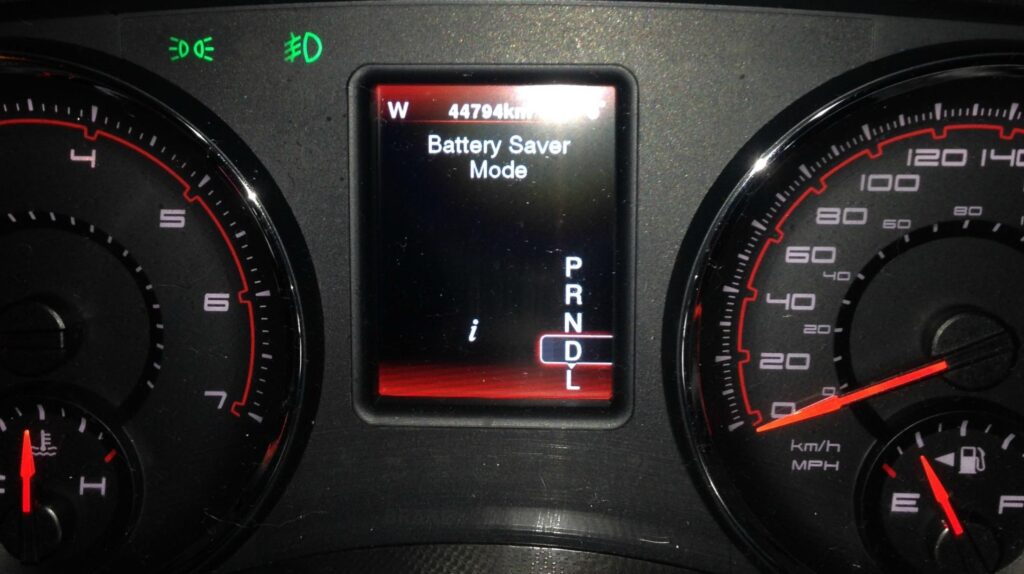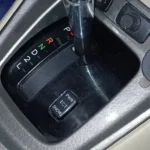Many contemporary vehicles, like the Dodge Charger, have a battery-saver mode to preserve the battery’s energy and prolong its lifespan. This function is particularly beneficial for individuals who frequently take short trips or have numerous accessories that consume the battery’s power. If the dashboard displays the “Battery Saver Mode” notification, it could indicate various problems, such as insufficient battery voltage, a malfunctioning alternator, an overloaded electrical system, excessive accessory use, or a software error.
Get ready to delve into the specifics of your inquiry, “Warning for Battery Saver Mode Dodge Charger.” Let’s discover exactly what steps you should take next!
Understanding Battery Saver Mode Dodge Charger
The Dodge Charger offers a battery-saving mode that helps conserve battery power. This Feature can be activated to limit or shut down specific electrical components and accessories to decrease the battery’s usage. This includes the radio, interior lights, power windows, and air conditioning.
The primary objective of the battery-saver mode is to prolong the battery’s lifespan by saving power during critical moments, such as when the battery is running low or the vehicle is idle. In certain situations, the battery-saver mode may also decrease the vehicle’s power output to conserve battery energy. It is important to note that activating the battery-saver mode may impact the vehicle’s performance and should only be utilized when necessary.
Understanding the Reason Behind Battery Saver Mode on Dodge Charger – Explanation of Error!
The indication of “battery saver mode” on the dashboard of your Dodge Charger can appear for various reasons, such as:
Insufficient Voltage for Battery:
The purpose of the battery-saving mode is to activate when the battery voltage falls below a specific limit. This function is enabled to save energy and prevent the battery from running out completely, potentially preventing the vehicle from starting. A decrease in battery voltage can be caused by different factors, such as leaving the lights on for a prolonged time, a defective battery, or an issue with the charging system.
Failure of the Alternator:
The alternator is vital to maintaining the battery’s charge while the engine is in operation. It produces electricity to operate the vehicle’s electrical systems and replenishes the battery. A malfunctioning alternator can result in insufficient battery charging, causing low voltage and activating the battery-saver mode.
Electrical System Overload:
The capacity of a vehicle’s electrical system is designed to handle power consumption. However, suppose there is a high demand for the system, such as using multiple accessories at once or leaving the lights on for a long time without the engine running. In that case, the battery-saver mode may be activated to avoid excessive battery draining. This precaution is necessary to maintain the battery’s lifespan and ensure enough power is available to start the vehicle.
Drainage of Accessories:
Certain vehicle accessories, such as power outlets, infotainment systems, or aftermarket installations, may consume energy even when the car is not in use. If these accessories are not working properly or wired correctly, they can gradually drain the battery. To avoid this, the battery saver mode is designed to detect and activate excessive energy usage to protect the battery from depletion.
Error in Software:
At times, the message for the battery-saving mode may pop up due to a software malfunction or flaw in the vehicle’s computer system. This could be due to using outdated software or a system bug. In these situations, updating the vehicle’s software or going to a service center to fix the problem may be necessary.
What is the Solution for Resolving the Battery Saver Mode on Dodge Charger?
Do you have concerns about disabling battery saver mode on your Dodge Charger? In case a warning message pops up on your car’s dashboard, there are a couple of steps you can take to resolve the problem:
Step 1: Inspect the Battery
To begin, utilize a multimeter to determine the battery’s voltage. The battery is in satisfactory condition if the reading is 12.6 volts or higher. However, the battery is deemed non-functional if the reading falls below 12.4 volts.
To resolve this problem, one must replace the battery with a fresh one if drained. If the battery’s voltage appears satisfactory, corrosion on the terminals could be the cause. This can hinder the charging of the battery and suggest that it needs to be replaced. It is essential to ensure that the battery is connected correctly and that there are no loose or corroded connections. This may resolve the issue.
If the car encounters difficulty after being turned on or fails to start, the battery may have lost its charge.
Step 2: Inspect the Alternator
During operation, the car’s alternator maintains a charged battery. In the case of malfunctioning, the battery may not be sufficiently charged, resulting in the display of a message indicating battery saver mode.
The following steps can be taken to identify if the alternator is responsible for a depleted battery voltage:
Inspect the alternator belt: If the alternator belt is not tight or damaged, it will hinder the charging of the battery by the alternator. Examine the belt for any signs of wear, looseness, or cracks, and if needed, replace it.
Monitoring battery voltage during engine operation: Use a multimeter to check the battery voltage while the engine runs. If the voltage reading exceeds 13.5 volts, the alternator will likely function correctly. Remember that the alternator may only operate correctly if the voltage reading is at least 13.5 volts.
Inspect for warning indicators: If the alternator is not working correctly, it could activate warning indicators on the dashboard, like the battery or check engine light.
Utilize a battery and alternator tester: This tool is designed to check the battery and alternator simultaneously. This will offer a more precise and thorough evaluation of any potential problems.
If you discover a faulty alternator, the solution would be to replace it with a new one. This should resolve the problem.
Step 3: Inspect the Electrical System of the Vehicle
If the brightness of the headlights decreases when you activate other electrical components like the air conditioning or radio, this could suggest that the electrical system is experiencing excessive load. To prevent this, ensure all lights and accessories are switched off, and the vehicle’s electrical system is not burdened. Otherwise, the battery-saver mode may be triggered.
Impact of Battery-Saver Mode on Vehicle Performance
The performance of a Dodge Charger can be impacted in several ways when the battery-saver mode is turned on:
- Power Output Decrease: When the battery-saver mode is enabled, the vehicle’s power output may be reduced to preserve battery power. This can lead to a decrease in acceleration and overall performance.
- Changes in Lighting and Accessories: Certain lighting and accessories may be turned off or limited to conserve battery power. This can include the interior lights, radio, and power windows.
- Possible Impact on Vehicle Functions: The battery-saver mode may limit or deactivate certain functions in the vehicle. This can include air conditioning, power steering, and the ability to charge devices through USB ports.
- Potential Impact on Fuel Economy: The activation of the battery-saver mode may also decrease fuel economy due to the reduced power output.
- Reduction of Safety Features: In the event of battery-saver mode activation, certain safety features, such as power steering and brakes, may be disabled. This can make the vehicle more difficult to control, particularly at low speeds or during tight turns.
The Dodge Charger is a well-known car model.
What are the Best Ways to Utilize the Benefits of Battery-Saving Mode?
For optimal utilization of battery-saver mode on a Dodge Charger, consider the following recommendations:
- Use the Feature Wisely: Only enable the battery saver mode when necessary to preserve battery life. Avoid using it as a regular driving mode.
- Regularly Check Your Battery: Ensure the battery is in good condition and fully charged. A healthy battery will have a longer lifespan and require less use of the battery-saver mode.
- Limit Accessory Usage: Whenever possible, turn off accessories such as the radio, interior lights, and power windows to conserve battery power.
- Minimize Short Trips: Short trips can quickly drain the battery. Try to combine errands or opt for longer trips to help preserve battery power.
- Maintain a Good Alternator: The alternator plays a crucial role in keeping the battery charged while the vehicle is in use. Ensure it is in good working condition to minimize the need for the battery-saver mode.
- Monitor Battery Voltage: Keep track of the battery’s voltage level to estimate its remaining power and how long it will last.
- Refer to the Owner’s Manual: Review the owner’s manual for your Dodge Charger to understand how the battery-saver mode functions and how to use it effectively.
By adhering to these suggestions, one can effectively preserve battery power and prolong battery life, maximizing the usefulness of the battery-saver mode feature.
FAQs
How does battery saver mode work on a Dodge Charger?
Battery saver mode on a Dodge Charger helps to conserve energy by automatically shutting off non-essential electrical systems when the battery voltage is low.
Will using battery saver mode affect my driving experience?
While using battery saver mode may dim certain interior lights and disable some features temporarily, it will not significantly impact your driving experience.
Can I manually activate battery saver mode on my Dodge Charger?
Yes, you can enable battery saver mode manually through the vehicle’s settings menu or by following specific instructions in the owner’s manual.
Is battery saver mode only beneficial for prolonging the life of my car’s battery?
In addition to extending the lifespan of your battery, using battery saver mode can also help prevent unexpected stalls or starting issues due to a drained battery.
Will using battery saver mode reduce the performance of my Dodge Charger?
Battery saver mode is designed to prioritize energy conservation without compromising the performance of your Dodge Charger under normal driving conditions.
What should I do if my Dodge Charger’s battery continues to drain despite using battery saver mode?
If you notice persistent battery drainage, have your vehicle inspected by a professional technician to diagnose any underlying electrical issues that may be contributing to the problem.
How long can I safely leave my Dodge Charger in battery saver mode without starting the engine?
It is recommended not to exceed more than a few hours with the vehicle in battery saver mode without starting the engine to avoid excessive strain on the electrical system.
Can I use accessories like the radio or air conditioning while in battery saving mode?
Certain accessories like the radio and air conditioning may be affected while in battery saver mode, as they draw power from the vehicle’s electrical system.

Summary
If the issue is essential, it can be solved independently, for instance, by addressing a loose battery cable or replacing a fuse. However, the problem is more intricate, like a malfunction with the alternator or electrical system. In that case, it may be advisable to seek assistance from a skilled mechanic for evaluation and resolution. Using specialized tools, a mechanic can examine the battery, alternator, and electrical system, identifying the source of the problem and conducting any essential repairs.
With this information, you should now be equipped to comprehend the “Battery Saver Mode Dodge Charger Error.” If you have any additional questions, please do not hesitate to contact us.










